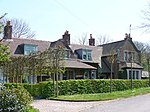Goleigh Hill
Hampshire geography stubsHills of Hampshire

Goleigh Hill is one of the highest points in the county of Hampshire, England. It is part of the Hampshire Downs and reaches a height of 220 metres (720 ft) above sea level. Goleigh Hill rises about 2.5 kilometres west of the village of Empshott in Hampshire and is one of the East Hampshire Hangers. The top of the hill is open. Wooded areas on its flanks included Goleigh and Lye Woods to the west and Abbot's Copse to the east. Goleigh Farm lies on the northwestern slope of the hill with Goleigh Manor in the valley below it. There is a trig point at the summit.
Excerpt from the Wikipedia article Goleigh Hill (License: CC BY-SA 3.0, Authors, Images).Goleigh Hill
East Hampshire Colemore and Priors Dean
Geographical coordinates (GPS) Address Nearby Places Show on map
Geographical coordinates (GPS)
| Latitude | Longitude |
|---|---|
| N 51.0723 ° | E -0.9638 ° |
Address
GU34 3SB East Hampshire, Colemore and Priors Dean
England, United Kingdom
Open on Google Maps







